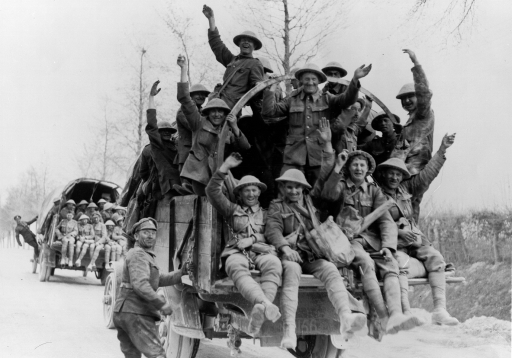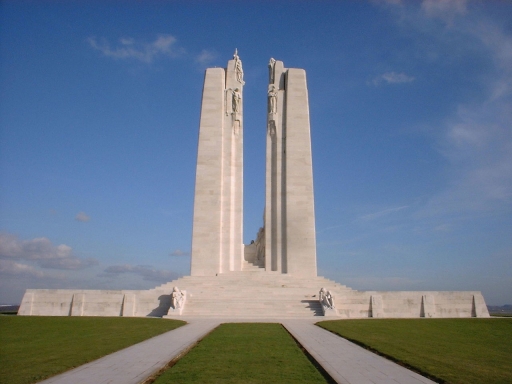Today marks the 97th anniversary of the Battle of Vimy Ridge, a battle considered a ‘coming of age’ for Canada.
Speaking to Centenary News, Jeremy Diamond, Campaign Director at the Vimy Foundation, explained that almost one hundred years on, the battle remains “a touchstone of Canadian identity”.
The Foundation is involved in an ambitious initiative to raise $10-$15 million dollars for a new visitor centre at the Canadian National Vimy Ridge Memorial in France, with an extra $5 million having already been pledged by the Canadian Government in May 2013.
The new centre is set to open in 2017 to mark the Centenary of the battle – with the year also marking 150 years since Canadian Federation – an opportunity which Mr. Diamond said was an “unprecedented opportunity to engage with Canadians about their history”.
Battle of Vimy Ridge
The 1917 Battle of Vimy Ridge was the first time that all four divisions of the Canadian Corps – some 20,000 men – had fought together.
Having been captured in October 1914 by the Germans, Vimy Ridge had been reinforced over a number of years and its position on the high ground gave the Germans a natural strategic advantage.
The battle was part of a large Allied offensive along the front line. The French attacked further south on the ridge of the Chemin des Dames near Laon, with a British diversionary offensive in the north around Arras, with the Canadians concentrated at Vimy.
The battle began on the 9th April 1917. By the end of the day, three of the four Canadian divisions had captured their objectives, with the fourth finally taking the heavily defended Hill 145 on the 10th, after being reinforced.
Canadian forces had made a breakthrough after three years of failed Allied offensives.
Vimy Ridge was imposing: Canadian forces had been faced with a series of reinforced trenches, concrete machine gun strong points and a mesh of barbed wire, as well as facing an uphill charge.
They endured 10,602 casualties, including 3,598 dead.
A reinforced machine gun point at Vimy Ridge
The battlefield still bears the scars of explosives which were buried in underground tunnels and ignited during the offensive
An intricate network of reinforced trenches had been developed by the German defenders
Four Victoria Crosses were awarded at Vimy Ridge, including one to Private William Milne of the 16th Battalion.
He earned the VC when he crawled up to a German machine gun that had been firing on advancing troops, bombed its crew and captured the gun. He later neutralised a second machine gun by killing its crew and capturing it. He was killed shortly after and his grave remains unknown.
Captain Thain MacDowell of the 38th Battalion earned his medal during the fight for Hill 145. After entering an enemy dug out, he convinced 77 Prussian Guards to surrender to him by stating that a large force of men was directly behind him. There were, in fact, only two men reinforcing him.
The valour shown and sacrifices made by Canadian troops at Vimy Ridge led Brigadier-General A.E. Ross to declare after the war that, “in those few minutes I witnessed the birth of a nation”.
Memorial
The Canadian National Vimy Ridge Memorial stands on the hard-won Hill 145. Its twin pillars of limestone sourced from Croatia represent Canada and France and dominate the skyline.
Designed by Walter Seymour Allward and unveiled by King Edward VIII in 1936, the memorial has etched at its base in English and French the words:
To the valour of their countrymen in the Great War and in memory of their sixty thousand dead this monument is raised by the people of Canada
Inscribed on the memorial are also the names of 11,285 Canadian soldiers who were declared missing and presumed dead.
Names of the missing inscribed on the ramparts of the memorial
The memorial underwent restoration in 2007 and was reopened by Queen Elizabeth II on the 90th anniversary of the battle.
Jeremy Diamond told Centenary News that for the 100th anniversary of the battle, the Vimy Ridge Foundation is hoping to engage with Canadians and develop their interest in a battle which is “at the heart of the history of modern Canada”.
Minister for Veterans Affairs, Steven Blaney, emphasised that the new visitor centre will “educate citizens and friends of Canada about the sacrifices and achievements of Canadians during the First World War”, and that through those sacrifices, “we found in ourselves a stronger sense of identity – of pride – in our brave nation”.
Mr. Diamond recognises the importance of education to mark the Centenary and said that he “wants to get people excited” – particularly the young – about the anniversary.
“Young people have access to more information than any other generation before them – the challenge is engaging them and then bringing the over to the Vimy Ridge Memorial”.
But, are Canadians interested?
Survey
Out of a population of seven million, 600,000 Canadians served in the Expeditionary Force and even more were mobilised on the Home Front.
This is a conflict which has left its mark – entire neighbourhoods lost most of their young men and cenotaphs and war memorials dedicated to the memory of those who fought in the First World War are still a common sight in Canada today.
However, a recent poll conducted for the Vimy Foundation highlighted a problem which most countries preparing to mark the Centenary of the First World War are encountering – knowledge about the conflict is limited.
 A machine gun emplacement on the crest of Vimy Ridge and the men who drove the Germans from it during the Battle of Vimy Ridge, courtesy of Library and Archives Canada / PA-001101
A machine gun emplacement on the crest of Vimy Ridge and the men who drove the Germans from it during the Battle of Vimy Ridge, courtesy of Library and Archives Canada / PA-001101
Four out of five Canadians were able to correctly identify that Vimy Ridge was a battle which Canadian troops fought in, but only 47% knew it was a First World War battle, with 37% believing that it was fought during the Second World War.
Three in ten thought that Vimy Ridge was where Canadian soldiers suffered heavy losses during D-Day in 1944.
Of the 1,105 Canadians surveyed, nearly one in ten (9%) thought that Vimy Ridge was a ski slope used for practice in the build up to the 2014 Sochi Winter Olympic Games.
It was also found that the over 55 demographic was most likely to know what Vimy Ride was (92%), compared with those aged 18-34, who were least likely to know at 69%.
The results of the Vimy Foundation’s survey echo those of a poll conducted by the British Council, which found that there was significant confusion between the First and Second World Wars and that younger people knew less about the conflict.
There were also notable differences in knowledge between French and English speaking areas of Canada. Quebec – which saw riots when conscription was introduced in 1917 – polled the lowest amongst Canada’s regions in a series of questions about Vimy Ridge, ranging from the battle’s impact, accomplishments or when it took place.
“Pilgrimage to Vimy”
Mr. Diamond acknowledged the challenges facing Vimy’s Centenary – and the Centenary of the First World War as a whole.
“We have pictures of the Vimy Memorial in our passports and now on our banknotes, but only four of Canada’s provinces have compulsory Canadian history at high school”.
However, those applying for Canadian citizenship must take a history test.
Mr. Diamond highlighted that this has led to the “unusual situation” where some naturally born Canadians know less about their own history than those who have gained citizenship later on in life.
 The Vimy Memorial features in Canadian passports, image courtesy of Passport Canada
The Vimy Memorial features in Canadian passports, image courtesy of Passport Canada
Although the Canadian Government has identified key anniversaries which it will commemorate, including the Gallipoli Campaign and the Battle of the Somme, Mr. Diamond expects that “the onus will remain on 2017”.
“Crucial part of history”
This year will see the groundbreaking for the new education centre and commemorations are taking place in Arras to mark the 97th anniversary of the battle.
Mr. Diamond said that he is hoping Vimy 100 will be of the same magnitude as commemorations for the 90th anniversary in 2007.
It is expected that Queen Elizabeth, as Canada’s head of state, will be present at commemorations, as will diplomats and VIPs.
Mr. Diamond hopes that the Centenary will also attract thousands of ordinary Canadians to take part in a “pilgrimage” to the monument.
“A large part of our military history is not in Canada, it is in Europe, more specifically France. The same is also true from an architectural point of view – the Vimy Ridge Memorial is one of our greatest structures and it lies abroad”.
He believes that it is important that “as many Canadians as possible have the opportunity to connect with such a crucial part of our history”.
Celebration vs. Commemoration
Mr. Diamond was clear that whilst the loss of life at Vimy was a tragedy, there should be a “celebratory element” to the commemorations.
“This was a big deal for Canada, the “birth of a nation”, and we should celebrate our accomplishments”.
 Victorious Canadian troops following the Battle of Vimy Ridge, April 1917 courtesy of Library and Archives Canada / PA-001332
Victorious Canadian troops following the Battle of Vimy Ridge, April 1917 courtesy of Library and Archives Canada / PA-001332
He also addressed arguments that the money being raised for the visitor centre should instead be spent on veterans returning from Canada’s current conflicts, most prominently, Afghanistan.
It is a question which governments across Europe have grappled with, but Mr. Diamond said it was important that funding for the care of veterans and funding for the centre is not seen as a case of “choosing one over the other”.
Give a Vimy
In May 2012, the Bank of Canada unveiled its new $20 bill, which features the Vimy Ridge Memorial.
With the aim of raising $10-$15 million for the new visitor centre, the Vimy Foundation is asking people to ‘Give a Vimy’ – a colloquial term for the $20 bill.
Mr. Diamond said that there has been an enthusiastic response to the initiative, with people from around the world contributing.
“We want people to feel that they can take an active role in ensuring that the memory of those who fought at Vimy lives on. Making a donation is one way of doing that”.
 The $20 bill, image courtesy of the Bank of Canada
The $20 bill, image courtesy of the Bank of Canada
All those who donate will have their names displayed at the education centre.
The Vimy Foundation is also planning fundraising dinners and other grass-root campaigns. Mr. Diamond praised the already positive response and hopes that people will choose to invest in what he describes as a “Canadian legacy project”.
Further information
Centenary News will be following the Vimy Foundation’s progress and preparations to mark the Centenary of the battle in 2017.
To find out more about the Vimy Foundation, click here.
To read the Centenary News analysis of the Vimy Foundation’s recent survey about Canadian’s knowledge of the battle, click here.
Images of Vimy Ridge battlefield and memorial courtesy of Daniel Barry, Centenary News
Posted by: Daniel Barry, Centenary News
© Centenary Digital Ltd & Author
